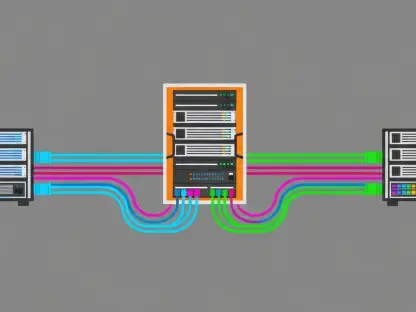Diving into the world of cybersecurity, we’re thrilled to sit down with Chloe Maraina, a Business Intelligence expert with a keen eye for data science and a deep understanding of cyber threats. With her knack for turning complex data into compelling insights, Chloe is here to unpack the recent record-breaking 15.72 Tbps DDoS attack on Azure and the growing dangers posed by IoT botnets. In this conversation, we’ll explore the scale and sophistication of modern cyber attacks, the systemic vulnerabilities in everyday devices, and what this means for both enterprises and home users in an increasingly connected world.
Can you walk us through the details of this massive 15.72 Tbps DDoS attack on Azure and what made it stand out?
Absolutely. This attack was a real eye-opener, even for a platform as robust as Azure. We’re talking about a staggering 15.72 terabits per second of traffic aimed at a single cloud endpoint in Australia. What’s wild is that it came from over 500,000 unique IP addresses worldwide, showing just how distributed and coordinated these attacks have become. Azure’s DDoS Protection platform kicked into gear, automatically detecting and redirecting the malicious traffic, so there was no disruption to customers. But the sheer volume—nearly 3.64 billion packets per second—highlights how attackers are leveraging vast networks of compromised devices to push the limits of even the biggest cloud providers.
How did Azure manage to detect and mitigate an attack of this scale without impacting its users?
Azure’s mitigation strategy is built on a layered defense system that’s always on the lookout for anomalies. They use real-time monitoring and machine learning to spot unusual traffic patterns, like sudden spikes in UDP floods, which dominated this attack. Once detected, their platform reroutes malicious traffic through scrubbing centers that filter out the bad stuff before it reaches the target. It’s a testament to their infrastructure that they could absorb and deflect such a massive hit without customers noticing a thing. But it also shows how critical it is for cloud providers to have terabit-scale capacity ready at a moment’s notice.
Why is the involvement of over 500,000 IP addresses in this attack so significant?
That number is a wake-up call. It means attackers have access to a huge, global pool of compromised devices, likely part of a botnet like the one tied to this incident. Each IP represents a device—think home routers, cameras, or smart gadgets—that’s been hijacked to send attack traffic. The diversity and scale make it incredibly hard to trace or block the source, as there’s no single point of origin. It’s like trying to stop a swarm of bees coming from every direction. This level of distribution also signals a systemic issue with device security worldwide, where millions of endpoints are just waiting to be weaponized.
What role do IoT devices play in fueling these kinds of attacks, and why are they such a persistent problem?
IoT devices are the perfect storm for attackers. We’re talking about everyday items—routers, security cameras, smart thermostats—that often ship with weak default passwords, outdated firmware, or no security features at all. Once connected to the internet, they’re easy targets for malware that turns them into botnet soldiers. The problem persists because many users don’t even realize these devices need securing, and manufacturers often prioritize cost and convenience over robust protection. Add to that faster home internet speeds and more powerful hardware, and each compromised device can pump out more attack traffic than ever before.
How are modern DDoS attacks evolving, especially with this trend of short, intense ‘hit-and-run’ strikes?
Modern DDoS attacks are becoming more like guerrilla warfare. These ‘hit-and-run’ strikes last just minutes, slamming a target with overwhelming force before vanishing. This particular attack used high-rate UDP floods with minimal spoofing, making it a blunt but devastating burst. The short duration makes them tough to counter because by the time defenses ramp up, the damage might already be done. It’s a shift from older, prolonged attacks to quick, surgical strikes that exploit any delay in response. This means organizations need always-on, preemptive protections rather than relying on reactive measures.
What’s behind the term ‘global cyber hygiene failure’ when describing the state of IoT security?
It’s a harsh but fitting label. ‘Global cyber hygiene failure’ points to the collective negligence in securing the millions of IoT devices out there. It’s not just a technical glitch—it’s a cultural and systemic issue where security isn’t prioritized at any level, from manufacturers shipping insecure products to users who don’t update them, to internet providers not filtering malicious traffic. The result is a vast army of vulnerable devices ready to be exploited in attacks like this one. It’s a shared failure that’s now posing real risks to critical infrastructure and economies worldwide.
Who do you think bears the most responsibility for fixing these IoT security gaps—manufacturers, service providers, or end users?
Honestly, it’s a shared burden, but I’d put the most weight on manufacturers. They’re the ones building these devices, often cutting corners on security to keep costs low. Mandating secure-by-default designs—like unique passwords and automatic updates—could prevent a lot of compromises. Service providers can step up with better traffic monitoring and filtering at the network level to catch botnet activity early. End users have a role too, but expecting every person to be a security expert isn’t realistic. Education helps, but the foundation needs to be built by those creating and managing the tech.
How are IoT botnets changing the landscape of DDoS attacks compared to older methods?
IoT botnets have taken DDoS attacks to a new level of sophistication. In the past, we saw mostly volumetric attacks—flooding a target with raw data to clog bandwidth. Now, with IoT botnets, we’re seeing smarter, layer-7 attacks that target specific applications or APIs, mimicking legitimate user behavior to slip past defenses. These devices also pack more punch individually thanks to better hardware and faster connections, so attackers need fewer of them to cause havoc. It’s a shift from brute force to precision, making detection and mitigation far trickier for even the best-protected systems.
What practical steps can everyday people take to ensure their devices aren’t contributing to these botnet-driven attacks?
It’s simpler than most people think, but it does take a little effort. First, change default passwords on all your devices—routers, cameras, anything connected—to something strong and unique. Second, keep them updated; manufacturers often release patches for known vulnerabilities, but you have to apply them. Third, if possible, isolate IoT devices on a separate network from your main devices to limit damage if one gets compromised. Lastly, consider disabling features you don’t need, like remote access, if you’re not using them. These small steps can make a big difference in keeping your gadgets out of a botnet.
Looking ahead, what’s your forecast for the future of DDoS attacks and IoT security as connectivity continues to grow?
I think we’re in for a rough ride unless some serious changes happen fast. As more devices come online—think 5G and the explosion of smart everything—DDoS attacks will only get bigger and more frequent. We’ll likely see even smarter attacks, blending AI to adapt in real-time and evade defenses. On the flip side, I’m hopeful we’ll see stricter regulations forcing manufacturers to prioritize security and more collaboration between providers and governments to filter malicious traffic at scale. But without a global push for better cyber hygiene, that blurry line between personal negligence and infrastructure risk is going to become a full-blown crisis.









